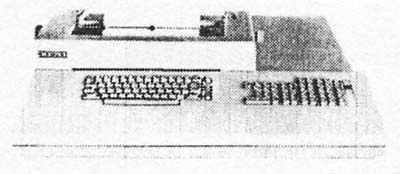Calculators sold by Sumlock and made by
other companies
Nixdorf & RUF Visible Record Computer

Nixdorf Visible Record Computer
There appeared in 1970 an advertisement for job opportunities in marketing and software[1] for:
"Visible
Record Computers.
At Computer 70
Sumlock Comptometer Ltd. will launch SERIES R, a new range of Visible Record Computers, including Accounting/Invoicing - Magnetic Stripe Ledger Card and Peripheral Equipment.
The Series will be R-5000, R-6000 and R-8000 ...
Product Appreciation and Training Courses—all expenses covered—to be held in September, November 1970 and January, March 1971.
...
Write or Phone: Sumlock Comptometer Ltd., Computer Division, 6th Floor, Northway House, High Rd., Whetstone, London N20."
These machines are advertised as being:
- R-6000 models - General purpose computer with card and tape input and output.
- R-8000 - Magnetic Ledger Card computer.
Nixdorf Visible Record Computer and the RUF Visible Record Computer appear to have been similar machines, but not identical. Since they have a common parentage they are treated together here.
Ian Partridge, was a training instructor for Sumlock service engineers from 1968 until 1975 first at Clerkenwell Road, London, then later at Apsley, near Hemel Hempstead when the training centre moved. Ian kindly provides the
following information about the Nixdorf accounting machines that were sold by Sumlock-Anita:
"The RUF machines were manufactured by Hohner (yes, the same as the musical
instrument makers!), and they were almost identical
to the Nixdorf accounting machines which were marketed earlier by Sumlock. The RUF was, if I remember a licence-built (by Hohner) version of the Nixdorf machine. Nixdorf's was finished in beige, whereas RUF was grey.
The Nixdorf Visible Record Computer appears to be a development of the same company's Logatronic programmable mini-computer for invoicing.
The machine was built into an office-desk sized arrangement. There was a specially modified IBM 'golf ball' typewriter set into the desk-top as an output device and a numeric keypad to its right hand side. Fitted to the typewriter was a feed unit for feeding in and printing the ledger account cards. Later versions of this had a reader for cards which carried a magnetic strip for user information. These were a source of trouble, I remember, aligning and setting these mag-stripe readers up to read correctly could be quite a job!
The electronics were housed on the left hand side in a 'filing-drawer' type of chassis, with individual plug-in circuit units. These were about 12 inches square by some one and a half inches thick—extruded aluminium frames with large printed circuit boards fitted into them. From memory there were several separate 'boards':
- CPU.
- 'micro' memory - machine coding (equivalent to ROM these days).
- 'macro memory' - application instructions (which was programmed individually for each customer).
- Read/write memory board (today's RAM).
- Input/output board - interfaces.
There was also a power supply unit, of course.
The memory units were all hard programmed by threading wires through a matrix of cores, and women were employed specially to do this 'knitting', working to programmers' charts.
I was fortunate to go on several courses both with Nixdorf in Paderborn and later with RUF in Zurich on these systems (see the RUF Accounting Machines). Also, for information about Heinz Nixdorf, the company, and its computers, including a photograph of one of these machines, see http://www.xnumber.com/xnumber/nixdorf2.htm.
Ian Partridge adds the following information:
"My introduction to these systems was when I was asked to add them to my repertoire as a training instructor. We (ie. Sumlock) had one or two branches which looked after the
Nixdorf VRCs—in North London and at Haywards Heath, among them. Somewhere around 1970 I went on a six week course at Nixdorf's training school in Paderborn. Later, after Sumlock had taken on the RUF agency for the
UK, I went several times to RUF-Buchhaltung, as they were called, in Zurich, with side trips to Trossingen, home of Hohner, where the systems were manufactured. I also had to learn quite a bit of German—but to this day,
my German is better in connection with electronics and computing than in the everyday sense! We actually learned the functioning of the electronics, and fault-finding, right down to component level. These days, it's all
done by changing complete boards or modules - another sign of changing times!"
Nick Law provides further information about the RUF and Nixdorf Visible Record Computers:
"In 1969 I was employed by RUF UK in Horley, Surrey, when it was taken over by Sumlock and later moved to Haywards Heath. T he RUF
manager had coined the term 'VRC' (Visible Record Computer) to emphasise for UK managers the fact that all forms used by the RUF computer systems could be read by HUMANS—as well as computers (so, if the computer
programs failed, accounting data could always be recovered). Accounting systems were very varied in the UK and when computerised, programs had to be individually written for each customer—in the rest of Europe, the 'RUF
Bookeeping' system was mainly used.
The 'RUF Praetor' computer was manufactured solely for RUF Buchaltung (literally RUF Bookeeping) of Zurich, by 'Nixdorf Labour Fur Impulstechnik' in Paderborne, Germany. A similar computer system was made for the firm 'Wanderer' in Germany (which I believe was sold as the 'Logatronic' by Sumlock). The Wanderer variant used slightly different electronics, but the main difference was that the RUF Praetor was normally fitted with a relay-operated form-feeding attatchment (RUF 'Intromat 54') allowing invoices to be produced, while updating the accounting ledger card records at the same time. The system looked very similar to the picture of a Logatronic system—the keyboard and IBM printer were recessed into a desk—but the printer had additional fittings to support the 'Intromat'.
Reference:
Anita Desk Calculators Using LSI Integrated Circuits
Text & photographs copyright © 2002 - 2023 Nigel Tout, except where noted otherwise.